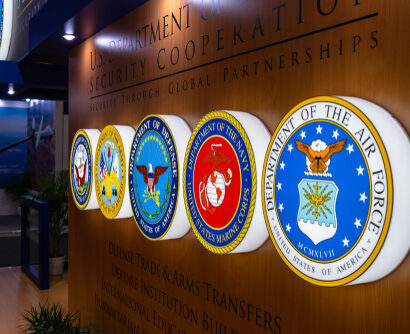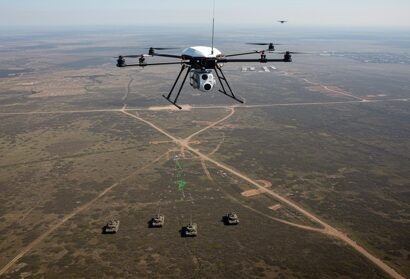Abstract: Emerging and disruptive technologies are certainly transforming modern warfare. As of recent, electronic warfare has become a significant threat through its availability to state and non-state actors. Take for instance South Asian states, which use Electronic Warfare to expand into space, thus broadening their horizons to space militarization. Such militarization is linked to the control of the arms race in space.
Bottom-line-up-front: India’s ambitions for space have turned towards militarization, which poses a security threat not only for Pakistan, due to a vulnerable space program, but the stability of the surrounding region as well.
Problem statement: How can Pakistan effectively minimize any potential threat of India’s militarization through counter capabilities?
So what?: In light of the emerging technological advancements that have transformed conventional into unconventional warfare, defensive counter-space capabilities are required for Pakistan to protect its space assets.

Source: shutterstock.com/Coffeemill
A “New” Battlefield
Modern military equipment and advancing technology pose a threat to global security. The utility of modern military prowess extends towards outer space. As such, outer space has become one of the new frontiers of modern times. Outer space, which was once considered a novelty and luxurious area, must be a high priority onwards. The exploration of outer space has led to global security concerns due to excessive militarization. The presence of military communication satellites, intelligence, surveillance, and reconnaissance satellites (ISR) inevitably directs towards space militarization – where space security becomes a major concern.
The increasing number of military satellites in outer space adversely affects the global security environment, specifically, regions such as South Asia which are characterized by fragile strategic stability. The states such as United States, Russia, China and India capable of launching indigenous satellites have enhanced on strategic capabilities that employ Intelligence, Surveillance and Reconnaissance (ISR), which threatens the vulnerabilities of weaker opponents. Likewise, it agitates the global security environment in outer space and on the ground altogether. The offensive capabilities acquired by these states challenge the global status-quo of space-faring nations, which is compelling enough for them to enhance their national security capabilities. By and large, the world is operating in anarchy and chaos with security threats growing daily.
The offensive capabilities acquired by these states challenge the global status-quo of space-faring nations, which is compelling enough for them to enhance their national security capabilities.
The term “militarization of outer space” refers to the capabilities of states to put satellites into outer space for assistance in communication and intelligence, reconnaissance, and weather reporting[1]. Militarization of outer space is often confused with weaponization, which can be described as the deployment of weapons-based command and control systems in outer space or on the ground. While the weaponization of outer space is linked to the use of Anti-Satellite systems (ASATs), it is not however limited to ASATs[2]. The weaponization and militarization of outer space includes the development of Inter-Continental Ballistic Missiles (ICBMs), Electromagnetic Pulse weapons (EMP) and Direct Energy Weapons (DEWs) along with other kinetic and non-kinetic technology possessing destructive capabilities.
Outer-space as Force Multiplier
Outer space has been viewed as a “force multiplier” by the Indian Air Force (IAF) since the Gulf War 2003, when space capabilities were incorporated into a ground operation against Iraq’s invasion of Kuwait. The event inspired IAF to integrate space capabilities into terrestrial air operations to enhance its operation capacity and ever since, it has been pressing on the increased use of space assets[3]. In 2005, India launched the CARTOSAT-I satellite, the first of its series dedicated to surveilling on Pakistan as an “eye-in-the-sky”. This was a first step towards using space as a force multiplier against an adversary. The CARTOSAT-2C launched on July 22, 2016, as an Indian military satellite that according to claims, was used to plan the so-called ‘surgical strike’ across LOC in the same year[4].
Pakistan’s space program has not yielded strong and sustainable assets that can employ space technology for civilian or strategic use. Due to increased space militarization, the nation’s space assets and ground facilities are rather vulnerable. India is increasingly fascinated with the militarization of its western border, which poses a direct threat to Pakistan’s handful of satellites and prompts quick action to safeguard. India purchased the S-400 missile defense system and deployed it in the Punjab region, strengthening its aerial military capabilities against Pakistan[5].
Due to increased space militarization, the nation’s space assets and ground facilities are rather vulnerable.
The advancement of space technology with remote sensing and imagery, navigation, signal intelligence (SIGINT) and optoelectronics provides high-definition reconnaissance and intelligence of up to 10km on the ground that has been acquired by India through its RISAT-2BR1 “spy satellite”. The RISAT-2BR1 is a Radar Imaging Earth Observational Satellite that marked the 50th launch mission of the Polar Satellite Launch Vehicle (PSLV)[6]. This spy satellite is capable of mapping earth during the day and night as well as in rainy and sunny conditions given its use of X-band synthetic aperture radar. The RISAT series satellites can capture images of the earth with the Synthetic Aperture Radar (SAR). The satellite can operate in different modes including Very High-Resolution imaging modes of 1m x 0.5m resolution and 0.5m x 0.3m resolution with a swath of 5 to 10 km, for areas on the ground. Put differently, RISAT-2BR1 is capable of laminating and taking images of a 5 to 10km area on the ground[7].
Why Counter Space Operations?
Pakistan’s space assets can be termed ‘soft targets’ as they are incapable of protecting themselves as such. It may be necessary for Pakistan to engage defensive space capabilities to counter space threats. The evident placement of the Space and Upper Atmosphere Commission (SUPARCO), the space agency of Pakistan, under the auspices of the Strategic Planning Division (SPD) since 2001 speaks volumes on the urgency of using space for strategic benefits along with commercial ones[8]. Defensive capabilities may increase the protection of the satellite and be able to detect malfunction or an external attack. In this regard, the Counter Space Operations (CSO), presents an opportunity to safeguard the space assets from kinetic and non-kinetic attacks. The aim of counter space operations lies in protecting friendly space assets from “attack, interference and unintentional hazards”. These operations can be conducted “before, during or after” the attack occurs, which accounts for defensive counter-space operations[9].
The aim of counter space operations lies in protecting friendly space assets from “attack, interference and unintentional hazards”. These operations can be conducted “before, during or after” the attack occurs, which accounts for defensive counter-space operations.
However, the soft threat arising from satellite jamming does not have many countermeasure options and involves high-security risk factors including disrupting communication links and damaging the electronics of the satellite. The counter space operations from Pakistan will make space assets susceptible to offensive space capabilities such as satellite jamming.
The Need for Defensive Capabilities
Pakistan’s strategic approach to space assets requires a defensive path rather than an offensive one. India’s offensive account as a space power threatens both regional stability and Pakistan’s security. In 2010, the Integrated Defence Staff Head Quarter stated in a policy document, “India will develop anti-satellite weapons ‘for electronic and physical destruction of satellites in both Lower Earth Orbit (LEO) and geo-synchronous orbits’. In fact, in 2010 the President of India, APJ Abdul Kalam, boasted about the Anti-Satellite technology of India during the Golden Jubilee celebration of the Defence Research and Development Organization (DRDO). He stated that India had the capability of intercepting and destroying any spatial object within a 200km radius. Nine years later, after professing its aspirations to the world, India realized its ambitions of militarizing outer-space. It conducted a successful ASAT test on 27, March 2019[10]. G. Satheesh Reddy, the DRDO Chief, pointed out some of the capabilities that India plans on acquiring including Directed Energy Weapons (DEWS), Lasers, Electromagnetic Pulse (EMP) weapons, and Co-orbital killers in 2019[11]. Such actions necessitate Pakistan’s need for defensive spatial capabilities. The Pulwama-Balakot crisis of 2019 was an alarming incident, where India violated the international border of Pakistan and released payload at Balakot, Khyber-Pakhtun Kha province of Pakistan, which points towards India’s belligerent nature[12]. The event could have possibly been avoided, had Pakistan had real-time spatial capabilities that might have apprehended the IAF aircraft’s flight towards Pakistan.
The current state of geo-spatial research and development in Pakistan requires a speedy process, which will enable it to defend itself against the offensive actions of India in the region.
Noor-Ul-Huda Atif is a Research Officer at the International Institute for Global Strategic Analysis, Pakistan. She holds a bachelor’s degree in Electronics and a master’s degree in Peace and Conflict Studies from NUST, Pakistan. Her main research interests are around Space Militarization, Space Security and Emergent Alternative Technologies in Global Security Architecture. The views contained in this article are the author’s alone.
[1] Alvin M. Saperstein, “Weaponization” vs. “Militarization” of Space, APS Physics & Society Newsletter, vol. 31, issue 3.
[2] Vinod Anand, “Integrated Defence Staff,” SP’s Military Year Book 2008-2009, SP Guide Publication (New Dehli).
[3] Idem.
[4] Mian Zahid and Raja Qaiser, “Space Programs of India and Pakistan: Military and Strategic Installations in Outer Space and Precarious Regional Strategic Stability” (2019), Space Policy 47: 63–75.
[5] ANI, “India deploys first S-400 air defence system in Punjab sector, to take care of aerial threats from China, Pakistan,” The Economic Times, India Times, December 21, 2021, last accessed on January 19, 2021, https://economictimes.indiatimes.com//news/defence/india-deploys-first-s-400-air-defence-system-in-punjab-sector-to-take-care-of-aerial-threats-from-both-china-pakistan/articleshow/88397852.cms?utm_source=contentofinterest&utm_medium=text&utm_campaign=cppst”.
[6] Helene Cooper, “Trump signs order to begin creation of space force,” The New York Times, February 19, 2019, https://www.nytimes.com/2019/02/19/us/politics/trump-space-force.html.
[7] Manoj Sharma, ”India holds first ever simulated space warfare exercise in July to counter China’s influence: report,” Business Today, June 8, 2019, https://www.businesstoday.in/current/policy/india-to-hold-first-ever-simulated-space-warfare-exercise-in-july-to-counter-china-influence/story/354412.html, accessed June 15 2019;
[8] Mian Zahid and Raja Qaiser, “Space Programs of India and Pakistan: Military and Strategic Installations in Outer Space and Precarious Regional Strategic Stability” (2019), Space Policy 47: 63–75.
[9] Todd Harrison, Kaitlyn Johnson and Makena Young, Defence Against the Dark Arts in Space, Center for Strategic and International Studies (CSIS), Washington DC, 2021.
[10] Rajeswari Pillai Rajagopalan, “India’s changing policy on space militarization: impact of China’s ASAT test,” India Rev. 10 (No. 4) (2011), 354-378, http://www.isro.gov.in/launchers/lvm3.
[11] Rajat Pandit, “India to hold first simulated space warfare exercise next month,” Times of India, 8 June 2019, last accessed July 16, 2019, https://timesofindia.indiatimes.com/india/india-to-hold-first-simulated-space-warfare-exercise-next-month/articleshow/69697289.cms.
[12] “Indian aircraft violates LOC, scramble back after PAF’s timely response: ISPR,” Dawn News, last accessed January 21, 2022, https://www.dawn.com/news/1466038.






